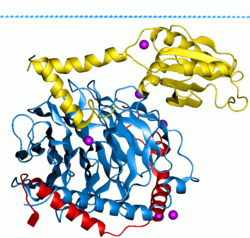Phosducin family
Appearance
 Phosducin (yellow) - Transducin beta-gamma complex | |||||||||
| Identifiers | |||||||||
|---|---|---|---|---|---|---|---|---|---|
| Symbol | Phosducin | ||||||||
| Pfam | PF02114 | ||||||||
| InterPro | IPR001200 | ||||||||
| SCOP2 | 1b9y / SCOPe / SUPFAM | ||||||||
| OPM superfamily | 131 | ||||||||
| OPM protein | 1b9x | ||||||||
| CDD | cd02987 | ||||||||
| |||||||||
The outer and inner segments of vertebrate retina rod photoreceptor cells contain phosducin, a soluble phosphoprotein that complexes with the beta/gamma-subunits of the guanosine triphosphate-binding protein, transducin. Light-induced changes in cyclic nucleotide levels modulate the phosphorylation of phosducin by protein kinase A.[1] The protein is thought to participate in the regulation of visual phototransduction or in the integration of photoreceptor metabolism. Similar proteins have been isolated from the pineal gland and it is believed that the function of the protein is the same in both retina and pineal gland.[2]
Human proteins containing this domain
[edit]| Gene | Aliases | Protein |
|---|---|---|
| PDC | MEKA | phosducin |
| PDCL | PhLP1 | phosducin-like |
| PDCL2 | GCPHLP | phosducin-like 2 |
| PDCL3 | PhLP2A | phosducin-like 3 |
| TXNDC9 | PhLP3 | thioredoxin domain containing 9 |
References
[edit]- ^ Craft CM, Lee RH, Fowler A, Lolley RN, McGinnis JF (1990). "Amino acid and cDNA sequence of bovine phosducin, a soluble phosphoprotein from photoreceptor cells". J. Biol. Chem. 265 (26): 15867–15873. doi:10.1016/S0021-9258(18)55479-X. PMID 2203790.
- ^ Takagi T, Abe T, Nakabayashi H, Tamada H, Sakuragi S, Yamaki K, Shinohara T (1990). "Analysis of the human, bovine and rat 33-kDa proteins and cDNA in retina and pineal gland". Gene. 91 (2): 209–215. doi:10.1016/0378-1119(90)90090-E. PMID 2210381.
